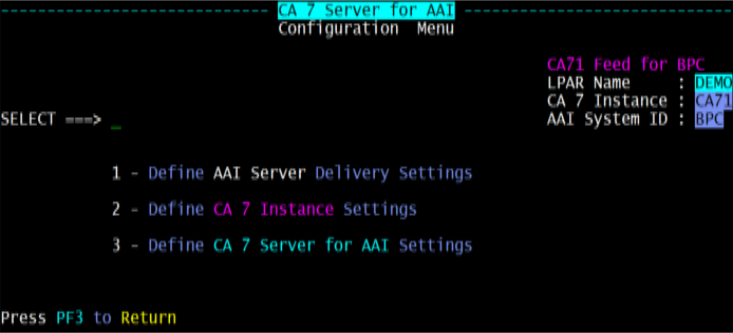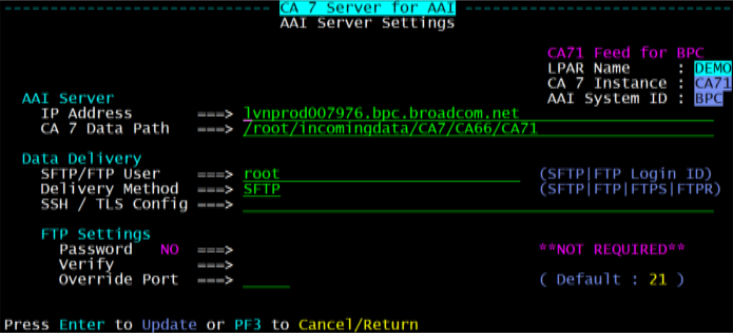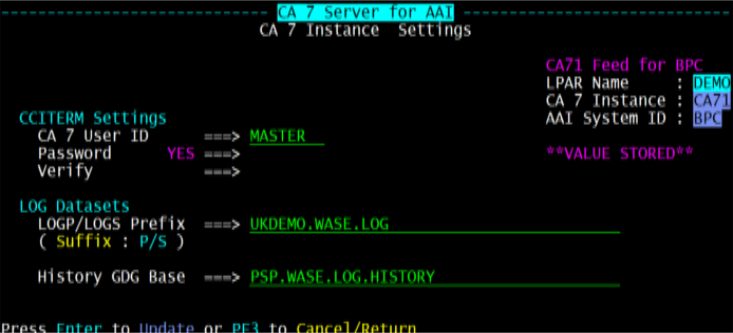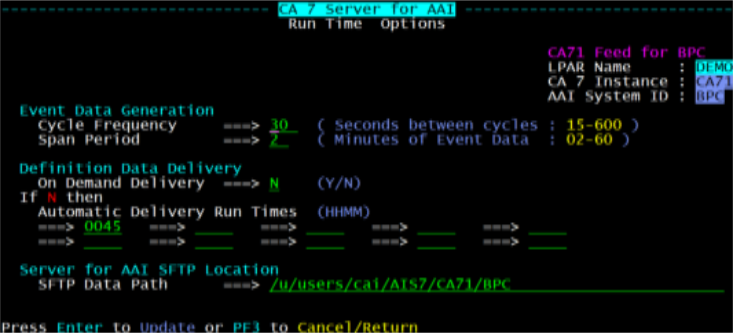Configuring an Instance of the CA7 Server for AAI
You have already defined the CA7 Server for AAI instance and you have created the execution datasets. Now you must configure it. You start by selecting C - CONFIGURE Instance Entry from the Instance Selection panel in IMS. This opens the Configuration Menu for the CA7 Server for AAI instance:

Configuring the instance involves the following steps:
Defining the Delivery Settings
First, you specify the settings for delivering data to the target AAI Server. Use the 1 - Define AAI Server Delivery Settings option to display the AAI Server Settings panel.

Specify the following values:
-
IP Address
IP address of the target AAI Server where the data from the CA7 Server for AAI will be delivered to.
-
CA7 Data Path
Directory path on the AAI Server where the CA7 instance data files will be delivered to.
There can be multiple CA7 instances delivering data files to the same AAI Server. Therefore, it is recommended that you use a directory naming structure that ensures that each CA7 instance delivers its data to a unique path.
Example:
.../CA7/LPAR_name/CA7_Instance
-
SFTP/FTP User
User ID on the target server. This User ID is used for connecting to that target server via the selected delivery method.
-
Delivery Method
The available data delivery methods are:
-
SFTP
-
A variety of FTP formats that include standard FTP or Secure FTP (FTPS / FTPR).
For Secure FTP, the FTPS setting allows the Secure FTP connection to be optional and used if available. The FTPR setting enforces that a Secure FTP connection is required
For more information, see Preparing for the CA7 Server for AAI Implementation.
-
-
SSH/TLS Config
When using SFTP (via SSH authentication) or Secure FTP (SSL/TLS) you might need to reference a User ID specific configuration file that contains override SSH or FTP parameters. These parameters change system-wide defaults to allow the connection and data delivery to work successfully.
Enter the path and file name for any such override configuration file in this field. Leave this field empty if no override configuration file is required.
-
Password/Verify
For FTP connections specifically, a password for the server User ID may be required. If so, enter it into both Password and Verify. Once entered, the password is encrypted to prevent unauthorized use.
Leave this field empty if no password is required for the FTP connection.
-
Override Port
For FTP/FTPS/FTPR connections, the default Port 21 may be blocked by a firewall setting. In this case, you must use an alternative Port. Specify any alternative Port number in this field, if required. Otherwise, leave this as blank to default to Port 21.
Defining the Scheduler Settings
Once the data delivery settings are defined, you configure the settings that are specific to the CA7 scheduler that the CA7 Server for AAI will be used for. Use the 2 - Define CA7 Instance Settings option in the Configuration Menu to display the CA7 Instance Settings panel.

Specify the following values:
-
CA 7 User ID
The CA7 Server for AAI signs on to CA7 using a CCITERM connection to obtain the required definition data for AAI. Then, it issues the various commands needed to produce the definition data files. You specify the CA7 User ID to be used for the CCITERM connection in this field.
For more information, see Preparing for the CA7 Server for AAI Implementation.
-
Password/Verify
If the CA7 User ID needs a password to sign on to CA7, specify it here. Once entered the password is encrypted.
-
LOGP/LOGS Prefix
Specify the dataset prefix for the Primary and Secondary CA7 Active LOG datasets. This prefix consists of all characters for the dataset names with the exception of the final P or S character used to identify the Primary and Secondary LOG datasets. It is assumed that this prefix dataset name is the same for both Active LOG datasets. These datasets are used to generate the Event Data file at regular intervals.
-
History GDG Base
Specify the GDG Base dataset name for the CA7 History LOG GDG. If required, the CA7 Server for AAI will use the CA7 History LOG datasets in the GDG to perform recovery of the event data at start-up.
Defining the CA7 Server for AAI Settings
Use the 3 - Define CA7 Server for AAI Settings option in the Configuration Menu to display the Run Time Options panel.

Specify the following values:
-
Cycle Frequency
Value in seconds that determines how often the CA7 Server for AAI generates a new event data file and delivers it to AAI. The value here must match the value defined for this frequency in AAI.
Recommended value: 30 seconds (default frequency with which AAI processes event data files)
This value can be set as low as 15 seconds (near real-time status updates in AAI). However, for large ca7 systems that run many jobs, a 15-second cycle may be faster than AAI can process, so a backlog of files may occur.
-
Span Period
Value in minutes that determines the period of time each event data file will include when it is created by the CA7 Server for AAI. This spans allows for an overlap of event data in each file to ensure no events are missed.
Recommended value: At least 2 minutes value which, when using a Cycle Frequency of 30 seconds, will provide 1 minute and 30 seconds of overlap event data in each file delivered to AAI.
-
On Demand Delivery
This setting determines whether the CA7 Server for AAI will automatically start the Definition Data Delivery child process at the specified time(s) or not.
-
N (recommended)
The CA7 Server for AAI automatically starts the definition data delivery process based on the specified time(s).
-
Y
No definition data files are generated automatically. Requests for definition data delivery must be issued to the CA7 Server for AAI in order for the definition data files to be generated and delivered.
-
-
Automatic Delivery Run Times
If the On Demand Delivery setting is N, you can specify up to 10 scheduled times here. These times determine when and how often the CA7 Server for AAI generates and delivers the definition data files.
By default, AAI processes definition data files only once per day at 1 am. This means that if you define more delivery times here, the setting in AAI must be changed to match them.
Note:Generating and delivering definition data for large CA7 environments can take as much as 40-50 minutes. Consider this when defining multiple delivery times. Set them early enough that the files are completely delivered before AAI starts processing them.
Example: IF AAI processes the definition data files at 1 am and their generation and delivery takes around 30 minutes to complete, set the value in the first Automatic Delivery Run Time field to around 0015 (fifteen minutes after midnight).
-
SFTP Data Path
To delivery the data files using SFTP, those files must be first temporarily copied into a USS directory on the mainframe before they can be transferred. Specify that directory in this field. Leave this field empty if you are using any other delivery type.
For more information, see Using SFTP and Dataset Sizingfor the largest data file that will be generated. See also the section on Dataset Sizing to determine the space needed in the USS directory.
Next Step
The last step to integrate the CA7 environment with AAI is to create the CA7 scheduler within AAI. For more information, see:
See also: